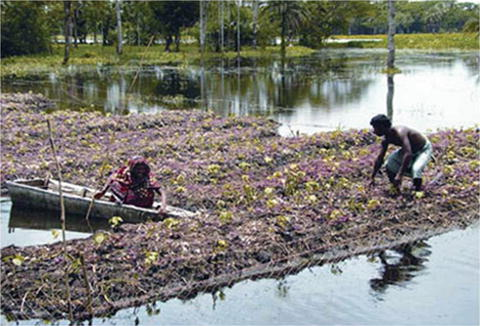Floating raft agriculture
What is it?

- Floating agriculture is a way of utilising areas which are waterlogged for long periods of time in the production of food. The technology is mainly aimed at adapting to more regular or prolonged flooding.
- The approach employs beds of rotting vegetation, which act as compost for crop growth. These beds are able to float on the surface of the water, thus creating areas of land suitable for agriculture within waterlogged regions. Scientifically, floating agriculture may be referred to as hydroponics.
- Floating raft farming had been taken up as a measure of improving adaptability and resilience in the background of climate change
Where can it be used?
- Floating agriculture can be used in areas where agricultural land is submerged for long periods
- The practice is similar to hydroponic agriculture whereby plants can be grown on the water on a floating bed of water hyacinth, algae or other plant residues.
- A typical example of floating agriculture involves a floating layer of water hyacinth, straw or rice stubble to which is added upper layers of small and quick-rotting waterworts(water plants) which make for good manure.
- India has many brackish water bodies which are conducive for such agriculture.
- Brackish water is a broad term used to describe water that is more saline than freshwater but less saline than true marine environments. Often these are transitional areas between fresh and marine waters. An estuary, which is the part of a river that meets the sea, is the best known example of brackish water.
Advantages
- Food Security: Mitigate land loss through flooding, by allowing cultivation of these areas to continue. In this way, the total cultivable area can be increased and communities can become more self-sufficient.
- Increase in productivity: In addition to this, the area under floating cultivation is up to 10 times more productive than traditionally farmed land and no additional chemical fertilisers or manure is required.
- Organic manure: When the crops have been harvested and floating rafts are no longer required, they can be used as organic fertilisers in the fields or incorporated into the following years floating beds as a fertiliser.
- Turning a curse to boon: The approach uses water hyacinth, a highly invasive weed with prolific growth rates, in a highly beneficial way.
- Elimination of harmful insects: By harvesting water hyacinth, areas covered by the weed are cleared, with the beneficial side-effect of reducing breeding grounds for mosquitoes and improving conditions for open-water fishing
- Pisciculture: By cultivating crops in water, it is also possible to simultaneously harvest fish populations which reside in the beds
- Additional income: The practice of floating agriculture also helps supplement the income of local communities and contributes to alleviation of poverty .
- Helps Landless farmers: It also provides greater food security by increasing the land output and supporting capacity for poor and landless people .
- Employment opportunities: The capacity to provide employment opportunities within communities and as both men and women can carry out the floating agriculture practices, it can also lead to improvements in gender equity.
Why in News:
- Floating raft agriculture experiments in the Alappuzha-Cherthala Canal in Kerala with amaranthus has shown success.
Reference:
Subscribe
Login
0 Comments
